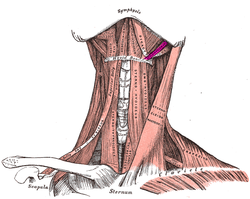Stylohyoid muscle
| Stylohyoid | |
|---|---|
 | |
| The stylohyoid among the triangles of the neck. | |
 | |
| Muscles of the neck. Anterior view. Stylohyoid muscle in purple | |
| Latin | musculus stylohyoideus |
| Gray's | p.392 |
| Origin | styloid process (temporal) |
| Insertion | greater cornu of hyoid bone |
| Artery | |
| Nerve | facial nerve (CN VII) |
| Actions | Elevate the hyoid during swallowing |
The stylohyoid muscle is a slender muscle, lying anterior, and superior of the posterior belly of the digastric muscle. It shares this muscle's innervation by the facial nerve, and functions to draw the hyoid bone backwards and elevate the tongue.
Origin and insertion
It arises from the posterior and lateral surface of the styloid process of the temporal bone, near the base; and, passing inferior and anterior, it is inserted into the body of the hyoid bone, at its junction with the greater cornu, and just superior the omohyoid muscle. It thus belongs to the group of suprahyoid muscles.
When contracted, it elevates the hyoid, this action is primarily brought about during swallowing.
It is perforated, near its insertion, by the intermediate tendon of the digastric muscle.
Variations
It may be absent or doubled, lie beneath the carotid artery, or be inserted into the omohyoid, or mylohyoid muscles.
Additional images
-

Left temporal bone. Outer surface.
-

Hyoid bone. Anterior surface. Enlarged.
-

Superficial dissection of the right side of the neck, showing the carotid and subclavian arteries.
-

Extrinsic muscles of the tongue. Left side.
-
Stylohyoid muscle
-
Stylohyoid muscle
See also
External links
This article incorporates text from a public domain edition of Gray's Anatomy.
| ||||||||||||||||||||||||||||

